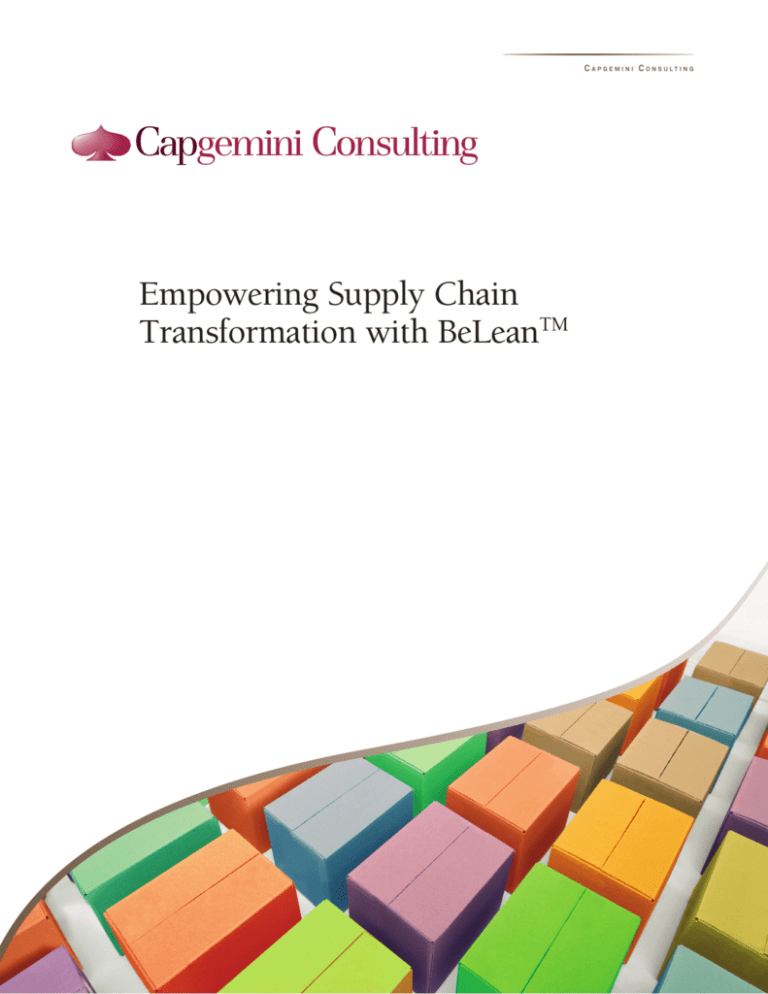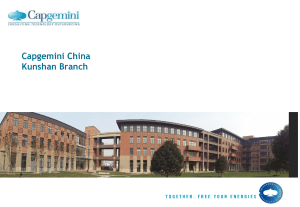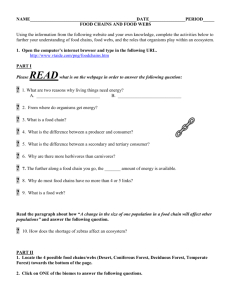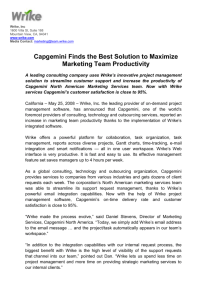
CAP GEMINI C ONSULTING
Empowering Supply Chain
Transformation with BeLeanTM
In collaboration with
LOGO
PLACEHOLDER
(TABLE)
LOGO
PLACEHOLDER
(TABLE)
LOGO
PLACEHOLDER
(TABLE)
The last 5 years has wreaked havoc
on supply chains across the globe.
Corporations are facing the reality
that they were unprepared to manage
their supply chains in a time of crisis
and are questioning whether they’re
prepared to manage their supply
chains as the market recovers. Just as
there is a new economic reality, so
too is there a new reality for
corporations to transform their
supply chains to be agile, adaptable,
aligned and lean.
One of the more daunting challenges
faced by companies across industries is
to efficiently manage their supply
chains, while still meeting the needs of
their customers and business partners.
Supply chains are extremely complex
and unforgiving organizations, making
the job of managing them a challenging
proposition, even under optimal
business conditions.
Consider the impacts of a prolonged
global economic downturn and a rash
of unpredictable natural disasters
coupled with geopolitical hot spots.
This makes for a “perfect storm” in
supply chain management for many
companies operating on a global
footprint. Some have become so
overwhelmed by the challenges
imposed by the current business
environment that they have forgone
any attempt at supply chain
management and instead are focused
on supply chain survival.
In an attempt to adjust to the new
economic reality, many corporations
took drastic cost-cutting measures that
produced short-term gain and longterm pain. Many lacked a cohesive
strategy and organizational structure
to adapt to changing events, while
some corporations across every
2
industry simply disappeared from the
business landscape.
The focus of this report is to identify
solutions as to how corporations can
better manage their supply chains in
the best of times and how such
solutions will prepare their
corporations to survive the worst of
times. We will also detail new
operating paradigms, taking advantage
of BeLeanTM thought leadership.
The Dangers of Being Fast
and Efficient
The Clarion call for supply chains since
the 1980’s has been to operate as low
cost, high speed, uber efficient entities
capable of transporting products from
suppliers to customers across the globe.
Executives touted the need for such a
supply chain mantra, and some leading
organizations were celebrated in industry
journals and held up as shining examples
of what other corporations should aspire
to achieve. As the 80’s became the 90’s,
however, academics and supply chain
consultants began to examine data related
to the performance of corporations with a
focus on low-cost, high-speed supply
chains and the results were nothing short
of astounding. As supply chain efficiency
increased, corporations were not
achieving a measurable competitive
advantage over rivals with less supply
chain focus. The results of the data led
researchers to ask the most important
question of all: why?
According to Dr. Hau Lee, the Thoma
Professor of Operations, Information
and Technology at the Stanford
Graduate School of Business, recently
completed groundbreaking research of
60 leading companies1. He contends
that companies with low-cost, highspeed supply chains have historically
failed to gain a sustained competitive
advantage over their rivals because they
are not able to respond to unexpected
changes in and challenges to their
demand or supply. Furthermore, Dr.
Lee’s research also identifies certain
companies that appear to have
established “bullet-proof” strategies
relative to their supply chains, thus
leading them to achieve a sustained
competitive advantage. These
companies’ supply chains are not just
low-cost and high-speed, but, most
importantly, they also have the
characteristics of being “Triple-A Supply
Chains” (see Figure 1), a term coined by
Dr. Lee. These characteristics include:
1.Agility: They are designed to respond
quickly to sudden changes in supply or
demand. They handle unexpected
external disruptions smoothly and costefficiently. Additionally, they recover
more quickly from shocks such as
natural disasters, product recalls and
economic turmoil.
2.Adaptability: They are built to evolve
over time as markets are reshaped by
such forces as economic growth and
contraction, political shifts, demographic
trends and technological advances.
3.Alignment: They are envisioned to
align the interests of all participants in
the supply chain with their own. As each
partner maximizes his own interests, the
supply chain’s performance is optimized
as well.
Regardless of business conditions,
companies can and should implement
supply chain strategies that provide
immediate and sustainable value to
their shareholders. Companies risk
their supply chain survival by
attempting to time the next cataclysmic
business, natural or geopolitical event.
Therefore, if they have not already
begun, companies would be wise to
begin exploring “Triple-A Supply
Chain” strategies that could well be the
selling better than forecasted, the
retailer adjusts to meet the new
demand. A company’s ability to act
quickly is directly related to having an
agile supply chain.
Figure 1: Completing a Triple Play
Agile
Becoming Adaptable
In addition to short-term fluctuations in
supply and demand and compressed
product lifecycles, markets themselves
are constantly changing more rapidly
than before, especially with the
expanding global economy. Supply
chain strategies and networks that once
served a company well can soon become
obsolete as market shifts occur.
Adaptable
Aligned
High-Speed
Low-Cost
key differentiator in keeping them
ahead of the competition.
agile supply chains respond both
quickly and cost effectively.
The best supply chains aren’t just fast
and cost effective. They’re also agile
and adaptable and ensure all a
companies’ interests stay aligned.
To clarify, agility is the ability to act
vs. react. When a hurricane strikes, all
supply chains in its path must alter
their daily routines to adjust to the
impact on customer needs. An agile
company maintains a laser-like focus
on weather conditions around the
globe, analyzing point-of-sale data to
ascertain which items sold more
frequently in past hurricanes and then
trucking in those extra items to stores
to meet customer demand. An agile
company would also pre-position
trailers loaded with items such as
water and food that could be
distributed easily.
Achieving Agility
The importance of having an agile
supply chain is reinforced by the
unpredictable outbreak of geopolitical
tensions, natural disasters and product
recalls that have proliferated over the
last few years. Great companies create
supply chains that respond to these
types of sudden and unexpected
changes quickly and efficienctly.
Agility is also critical, because, in most
industries, both demand and supply
fluctuate more rapidly and widely than
ever before. Most supply chains cope
by playing speed against costs, but
To create an adaptable supply chain,
Dr. Lee suggests companies should:
n Closely monitor global supply
chain economics
n Outsource more where possible
as outsourcing can enable more
rapid adaptability
n Understand completely the impact
that new product design has on the
supply chain
n Build different supply chains for
specific market and product
characteristics
n Understand the impact and benefits
of adopting new paradigms, like
Green Supply Chain, to drive
benefits across the supply chain.
Another example of an agile company
would be a retailer that captures and
analyzes Point of Sale data and, after
determining that certain SKU’s are
Empowering Supply Chain Transformation with BeLean
3
Creating Alignment
Supply chain alignment can only be
achieved through strong leadership and
a well-crafted supply chain strategy.
Effective leaders understand the
importance of identifying the role each
partner plays in the supply chain and
then creating an environment that
embraces collaboration among these
partners. Collaboration is essential in
fostering a sense of shared responsibility
that enables the supply chain to operate
at peak efficiency across all performance
drivers including:
n Facilities
n Inventory
n Transportation
n Information
Once a collaborative environment is
established, companies and their
partners can cooperatively build an
overall supply chain strategy. With
expanding global supply chains,
companies that choose not to include
supply chain partners in their strategic
initiatives do so at their own peril.
Companies should foster supply chain
alignment with their business partners
based on shared core values that include:
n Information exchange: Share data and
knowledge freely with partners,
vendors and customers
n Clarity in process and task ownership:
Identify roles, tasks and responsibilities
clearly for all stakeholders involved
n Equitably share risks, costs and gains of
improvement initiatives
The Difficulty of Achieving
Supply Chain Transformation
The challenge for any corporation
wanting to improve the performance of
their supply chain is turning vision
into reality. Becoming agile, adaptable
and aligned will return significant
improvements across the supply chain,
but achieving such a state will require
4
transformational change across the
corporation: A positive shift in the
business culture of an organization can
occur as a result of a change in the
underlying strategy and processes that
the organization used in the past.
Achieving transformational change is
critical as supply chains impact
corporations across nearly every
department internally as well as
externally across suppliers, customers,
and supply chain partners. Without a
holistic approach to improving the
supply chain, organizations run the risk
of achieving improvement only across
isolated aspects of the supply vs.
improving performance across all six
drivers of supply chain performance:
facilities, inventory, transportation, data/
information, procurement, and pricing.
Companies are approaching supply
chain transformation by realigning
their organizational structure to
optimize the execution of critical-path
processes. These companies are
deliberately analyzing how their supply
chains are managed, resourced, and
streamlined to focus on eliminating
non-value-added activities.
Figure 2: BeLean™ Sustainable
Results
Process
People
Do The
Work
Right
Do The
Right
Work
Manage
The Right
Way
Organization
With the help of Capgemini
Consulting, companies are specifically
employing traditional Lean-Six Sigma
practices in driving organizational and
behavioral change to optimize supply
chain transformation. This approach,
known as BeLean™, helps companies
focus their supply-chain organization
and processes on doing the right work,
working the right way, and managing
the right way.
BeLean™ strives to achieve repeatable
and reproducible transformational
change that reduces organizational
complexity within a company’s supply
chain. As a result, organizations can:
n Achieve greater levels of collaboration
– leading to better alignment with
internal and external customer needs
n Become more agile to adapt to changing
business requirements, customer
demands, and economic realities
n Embed the desired behaviors,
competencies and governance within
the organization for sustainable success.
By utilizing such an approach,
improvements are achieved more
broadly across the corporation, and
not just the supply chain (see sidebar).
There are countless examples of
corporations that have followed a
similar strategy when attempting to
improve the performance of their
supply chains and each failed to
achieve the desired results.
Although not easy, achieving supply
chain transformation is possible for any
company that is willing to invest in the
process. The time to begin is now.
Case Study: Lessons Learned
A global manufacturer attempted
to improve the performance of their
supply chain by focusing primarily on
implementing supply chain technology
to improve Sales & Operations Planning
(S&OP), demand planning and forecasting,
and transportation management. Over
a two-year period, millions of dollars
were invested in the implementation of
the software and integration with the
corporate ERP platform. Upon completion
of the project, the corporation expected to
achieve double-digit improvements across
inventory reduction, forecast accuracy,
and reduced logistics costs. As with many
such projects, however, the metrics failed
to achieve the desired results for the
following reasons:
n
n
Without changing the organizational
structure of the corporation to
take advantage of the increased
capabilities provided by the software,
the same people remained in place
and resisted using the software or
changing their processes.
The scope of the supply chain
transformation was too narrow and
failed to adequately identify a myriad
of other issues negatively impacting
the performance of the supply chain.
Figure 3: The BeLean™ Approach
BeLean
II:
n y
Sustainable
tio ilit
Results
ra inib
e
n a
Ge ust
Continous
Lean
S
Improvement
Performance
Mechanisms
Management
Process- Do The Right Work
TM
I: n
ion io
at at
er orm
n
f
Geans
Tr
Lean
Design
Management
Asset
Integrity
Excellence
People - Do The Work Right
Organization - Manage the RightWay
Organizational
Design
Excellence
System
Demand
Reduction
Optimized
Flow&Pull
Systems
Quality
Assurance
Systems
Model Site
Creation &
Best Practice
Waste
Elimination
Programmers
Stakeholder
Engagement &
Communications
Leadership
Vision &
Behaviors
Operational
Measurement &
Reporting
Value Stream
Mapping &
Base lining
Voice
of the
Customer
SS
Visual
Workplace
Getting Started with
Your Transformation
As a first step, companies should ask
themselves the following questions
before embarking on a supply
chain transformation:
1.Do we have internal resources with
the required expertise to design and
implement a supply chain
transformation?
2.What technology enablement will
be required?
3.What should we measure, and how
do we baseline our current supply
chain performance?
4.How do we define what constitutes
an optimal supply chain for our
business and industry?
5.How do we identify additional
opportunities to reduce our costs?
6.Do we have strong enough
relationships with our suppliers and
customers to foster their engagement
and collaboration? How do we know
we have the right suppliers and
customers to maximize the
profitability of our company?
7.Once we have designed an optimal
supply chain, how do we maximize its
capabilities and sustain its performance
across the business enterprise?
Lean Practitioner
Training &
Toolbox
Lean
Centre of
Excellence
8.How do we design and implement
the optimal supply chain for our
business today and the future?
Resolving these questions is crucial
due to the difficulty of enabling a
supply chain transformation. Many
companies come to realize that
undertaking such an effort is beyond
their capabilities and seek the
assistance of consulting partners to
provide supply chain expertise across
process, people and technology.
For example, companies may need a
partner that can immediately identify
specific links in the supply chain that can
be improved through various diagnostic
and assessment methodologies. This can
build a sense of confidence that all aspects
and drivers of a supply chain overhaul
have been considered.
Another advantage for companies that
solicit the services of a consulting firm
is the access they provide to software
and other technologies to support their
supply chain transformation efforts,
such as supply chain modeling and
execution tools. Modeling the supply
chain provides a clear understanding
of baseline supply chain costs and
Empowering Supply Chain Transformation with BeLean
5
“
Although not easy, achieving
supply chain transformation is
possible for any company that is
willing to invest in the process
”
and lanes, and production processes
that will satisfy customer demands.
n Supply chain execution is the
process of determining solutions to
more tactical issues, such as local
inventory policies and deployment,
manufacturing and service schedules
and transportation plans.
configuration. It also provides output
identifying a “to be” supply chain
configuration, balancing the lowest
costs with the highest throughout.
As companies often do not have a true
appreciation of the operational
complexities and costs of running their
supply chains, in-depth supply chain
modeling and analysis can provide
many “aha” moments. Supply chain
modeling identifies opportunities to
reduce costs across the supply chain
drivers of facilities, inventory,
transportation, procurement and
pricing (see Figure 4). It focuses on
two core areas:
Average companies model their
network every 2 ½ years but best-inclass companies model their network
every quarter.
Organizations that utilize the tools and
principles of Lean Six Sigma in
conjunction with network modeling
achieve an additional benefit of being able
to capture the voice of the customer and
align the business to ensure the changing
needs of the customer are being met.
Companies that don’t utilize Lean Six
Supply chain design is the process of
determining the supply chain network
and infrastructure — the plants,
distribution centers, transportation modes
Figure 4: Building Supply Chain Models
6
Transportation Shipping
Planning
Logic - POLICIES
PHYSICAL : 1 Products
2 Sites
BEHAVIORIAL POLICIES:
4 Inventory 5 Sourcing 6 Transportation
End Use Customer - Demand
3 Demand
3
3
2
2
Distribution Center
Distribution
4
Inventory
POLICIES
Manufacturing /
Production Workcenters
1
2
1
6
5
Sourcing
POLICIES
Raw
Materials
Resources
5. Many processes were manual or
redundant throughout the
corporation leading to increased
complexity and reduced performance.
6. There was too much inventory and
not enough of the products
customers wanted.
Figure 5: Modeling Questions for the Value Chain
How much product should be
sourced from each supploer or plant?
How many DCs should there be? Where
shoud they be located?
What’s the impact of new replenishment
practices inventory? On shipping costs?
Which ports of entry should be utilized
imports?
Which operations should be outsourced
Which customers should be served by
which DC?
What is the effect of demand
seasonality?
How should inventory be deployed
across the DCs?
Is direct store delivery the best option?
STORES
SUPPLIERS
Sourcing/
Manufacturing
Inbound
Logistics
Processing/
Converting
Distribution
Ordering
Management
& Execution
CUSTOMERS
Does criss-docking high velocit items
make sense?
How far should DCs be located from
customers/ stores?
How can inventory cost be balanced
against service needa and distribution
costs?
What sales channels are supported by
each DC (e.g.,retail, direct, third-party)?
How about reverse logistics?
What is the best mode mix?
Sigma are confronted with the ugly reality
of complexity within their departments
and across their organization and find it
nearly impossible to make continuous
changes to their network even if they’re
utilizing supply chain and network
optimization software.
An Inside Look at Achieving
Supply Chain Transformation
Utilizing BeLeanTM
A global food manufacturer who
supplies their products to hundreds of
retailers was experiencing logistics and
operational challenges within its supply
chain and partnered with Capgemini
Consulting to identify the root cause of
the issues and to identify the required
solutions. Recognizing the importance
of applying the principles of BeLeanTM
in conjunction with advanced supply
chain modeling and analysis, Capgemini
Consulting engaged in an approach to
immediately begin adding value for the
customer by conducting assessments
across people, process, and technology
that would position the company to
achieve their desired goals.
Results of the assessments and supply
chain modeling indicated the following
opportunities for improvement:
1. The corporation was organized in
such a fashion that silos were
allowed to exist, thus limiting
collaboration across internal
departments and external customers
and suppliers.
2. Supply chain technology could enable
improved performance, but critical job
functions lacked skilled employees.
3. Although available, data was not
collected and analyzed to identify
opportunities to reduce costs,
improve performance, or make
better business decisions.
4. Procurement of transportation and
3PL providers was based primarily on
lowest cost, resulting in transportation
cost reduction, but leading to poor
customer service levels.
After reviewing the results of the
assessments with the customer, we
designed and implemented a holistic
and detailed transformation plan to
achieve the desired goals of the
customer becoming agile, adaptable,
and aligned across the supply chain
and the corporation. Among the
changes implemented were:
1. Reorganizing multiple departments
to eliminate silos and increase
collaboration across internal and
external personnel. Note: This is a
key first step within BeLeanTM to
eliminate complexity
2. Hiring and assigning personnel
experienced in the use of supply chain
technology as well as experience in
maximizing the capabilities of such
software to increase ROI and
streamline operations
3. Designing process improvement
strategies in collaboration with
corporate personnel to ensure
continuous improvement became part
of the corporate DNA vs. being viewed
as nothing more than a project.
4. Holding collaborative sessions with
suppliers and customers to capture
“Critical to Quality” and “Voice of
the Customer” requirements.
Sessions focused on identifying
opportunities and real-world
strategies for increased collaboration
Empowering Supply Chain Transformation with BeLean
7
About Capgemini
Capgemini, one of the world’s
foremost providers of consulting,
technology and outsourcing services,
enables its clients to transform and
perform through technologies. Capgemini
provides its clients with insights and
capabilities that boost their freedom to
achieve superior results through a unique
way of working, the Collaborative Business
Experience™. The Group relies on its global
delivery model called Rightshore®, which
aims to get the right balance of the best
talent from multiple locations, working as
one team to create and deliver the optimum
solution for clients. Present in more than 35
countries, Capgemini reported 2009 global
revenues of EUR 8.4 billion (approximately
USD $11.6 billion) and employs 100,000
people worldwide.
1
Balancing the art of supply chain
management with the science of
supply chain optimization and
incorporating the BeLeanTM
methodology, provides an unequaled
strategy for supply chain transformation.
Capgemini Consulting is the Global
Strategy and Transformation Consulting
brand of the Capgemini Group, specializing
in advising and supporting organizations
in transforming their business, from the
development of innovative strategy
through to execution, with a consistent
focus on sustainable results. Capgemini
Consulting proposes to leading companies
and governments a fresh approach which
uses innovative methods, technology
and the talents of over 4,000 consultants
world-wide.
For more information:
http://www.capgemini.com/services/
consulting/
Rightshore ® is a trademark belonging to Capgemini
The Triple-A Supply Chain,” Dr. Hau L. Lee, Harvard Business Review, 2004.
References
Brittain Ladd, In Search of Supply Chain Excellence, 2009, The Pennsylvania State University
Sunil Chopra, Peter Meindel; Supply Chain Management, 3rd Edition.
Dr. Terry Harrison, Global Supply Chain Design, 2001. The Pennsylvania State University
The Triple-A Supply Chain, Dr. Hau L. Lee, Harvard Business Review, 2004
Lora Cecere, AMR Research, 2007
Craig Jones
Principal
North America Supply Chain
Management Group
Phone +1 703 928 5157
craig.e.jones@capgemini.com
Brittain Ladd
Managing Consultant
North America Supply Chain
Management Group
Phone +1 214 470 1249
brittain.ladd@capgemini.com
©2011 Capgemini. All rights reserved. Capgemini Consulting is the strategy and transformation consulting brand of Capgemini Group
008_CC_ESCTPOV_012111
The relationship with the customer
has advanced from that of
consulting partner to strategic
partner as a result of the significant
achievements from the supply chain
and corporate transformation. By
attacking and eliminating non-value
added processes and functions
across the corporation, the client
actually reduced their overall size
while increasing their operational
capabilities. That’s the power of
incorporating BeLeanTM.
The Bottom Line
Supply chains that are agile, adaptable
and aligned — in addition to being low
cost and high speed — have been
shown to provide a significant
competitive advantage. Achieving this,
however, requires the ability to
implement transformational change
not only across the supply chain, but
across the entire organization.
®
5. Applying the use of sophisticated
statistical and mathematical
modeling to mine data to capture
true operating and performance
metrics as well as identify
opportunities to make better
business and procurement decisions
6. Creating operational dashboards to
provide “one version of the truth”
related to actual performance with a
key focus on measuring data
designed to help the client
continually align the supply chain
with the voice of the customer and
the business as well as identify
potential problem areas across
production and food safety
7. Conducting an SKU/activity profile
analysis to identify the optimal
SKU’s to carry and align the layout
of the DC’s with the required
technology and operational strategy.
8. Applying the recommendations from
the supply chain modeling and
network optimization to consolidate
and close facilities, thus reducing
fixed costs and inventory while
increasing operational performance.








